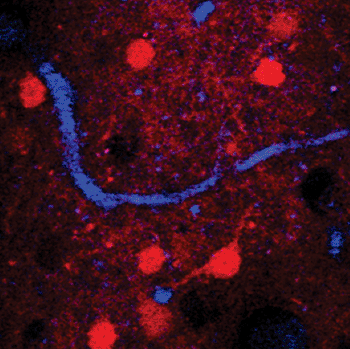3-Photon Microscopy Breaks Depth Limit of Current Biological Tissue Imaging
By LabMedica International staff writers
Posted on 07 Feb 2013
In a proof-of-concept study of a live mammalian brain, scientists have now shown that 3-photon microscopy enables high-resolution, noninvasive in vivo imaging at unprecedented depths of complex biological tissue, breaking the fundamental depth limit of standard 2-photon microscopy.Posted on 07 Feb 2013
The team of scientists, at Cornell University (Ithaca, NY, USA), have demonstrated a three-fold improvement in the depth limit of fluorescence-based biological tissue imaging over the widely used 2-photon microscopy (2PM) based technology (invented at Cornell in 1990). Tissue scattering limits the maximum imaging depth of 2PM to the cortical layer of the mouse brain, and imaging subcortical structures currently requires the removal of overlying brain tissue or the insertion of optical probes. Senior investigator Chris Xu, associate professor of applied and engineering physics, and colleagues have now demonstrated high-resolution, 3D imaging of the subcortical region of a live, intact mouse brain using 3-photon microscopy (3PM) based imaging technology (invented at Cornell in 1995).

Image: A horizontal frame from 3D reconstructed 3-photon microscopy images in a mouse brain. Red: neurons, blue: blood vessels, dark holes: nonfluorescent neurons (Photo courtesy of Prof. Xu’s laboratory, Cornell University).
The study, published online January 20, 2013, in the journal Nature Photonics, describes 3-photon fluorescence combined with a longer excitation wavelength of the laser pulse to overcome obstacles such as tissue scattering and absorption, which have prohibited high-resolution imaging deep within biological tissues. Dyes and transgenic mice were used to test the 3PM on different fluorescent signals. Using the live mouse brain model, the researchers have proved the principle of 3PM operating at a wavelength of 1,700 nanometers and this, in combination with the new laser developed specifically for 3-photon excitation, allowed for the high-resolution imaging at unprecedented depths within the brain—vascular structures as well as neurons within the mouse hippocampus were imaged.
"With MRI, we can see the whole brain but not with the resolution we have demonstrated. The optical resolution is about 100 to 1,000 times higher and allows us to clearly visualize individual neurons," said Prof. Xu. Pushing these depth limits is important for basic science and could also prove useful clinically, Prof. Xu noted. Depression and diseases like Parkinson's and Alzheimer's are associated with changes deep inside the brain, and finding the cures could be helped by subcortical neural imaging—below the gray matter, into the white matter and beyond, if the brain is visualized as stacked layers. If 3-photon microscopy can be used to map the entire brain, it could pave the way to new breakthroughs in neuroscience as well as other clinically relevant areas.
Related Links:
Cornell University














